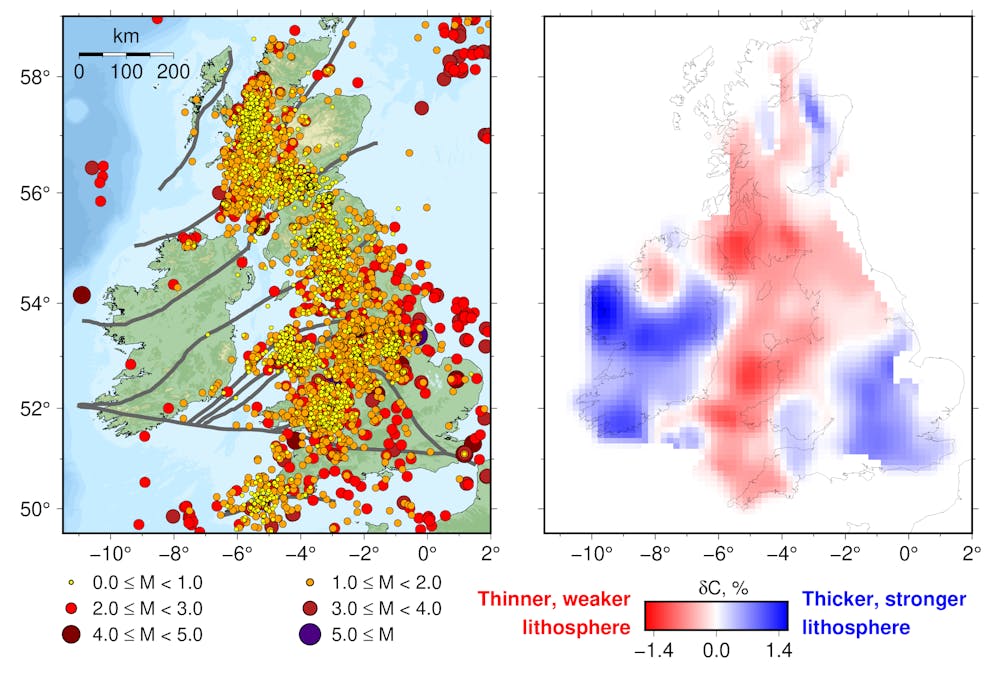Talks, field trips and events organised by west country geological organisations are publicised on this blog. Discussion about geological topics is encouraged. Anything of general geological interest is included.
Saturday 29 July 2023
Lightless Life
Icelandic Eruption - Continued
Icelandic Eruption - Continued
Down to Earth Extra August 2023
Down to Earth Extra August 2023
Friday 21 July 2023
A Geologic Quiz from the BBC
A Geologic Quiz from the BBC
Saturday 15 July 2023
Saturday 8 July 2023
Two 1-Day Field Course with Nick Chidlaw
Two 1-Day Field Courses with Nick Chidlaw
Google Earth image of the study area in the north-east Black Mountains. The narrow ridge on the right of the image is known as the 'Cat's Back' and provides accessible footpath exposures in the uppermost part of the Freshwater West Formation and the lower part of the Senni Formation. These strata are also exposed in the big landslide scars on the left of the image at 'Red Daren' and 'Black Darren'.
-----------------------------------
OLD RED SANDSTONE LOCATIONS IN THE SOUTHERN WELSH BORDERLAND: tropical arid-climate river deposits exposed by ice age and post-ice age processes; Ross-on-Wye and near Symonds Yat
Sunday 10th September 10.00 am - 5.00 pm
The Old Red Sandstone Supergroup is found in many parts of the British Isles, and mostly represents the deposition of sediment eroded off mountains and uplands elevated during the Caledonian and Acadian Orogenies, in the Silurian and Devonian periods respectively. The British crust at these times was located in the southern tropics and had a hot arid-semi-arid climate with rainy and dry seasons. The sediment was transported by river systems and deposited across lowlands in channels, flood plains and lakes.
The strata to be examined on this course includes the Brownstones Formation (Early Devonian age), and the Huntsham Hill Conglomerate Formation and Tintern Sandstone Formation (Late Devonian - earliest Carboniferous age). The Brownstones are exposed in a large road cutting and natural crags near the River Wye at the town of Ross, and the younger strata in extensive natural crags on the edge of the Forest of Dean near Symonds Yat. The Brownstones represent higher energy river systems than of those strata studied on the Black Mountains course. The late Devonian - earliest Carboniferous strata were deposited after the Acadian Orogeny (Mid Devonian times) and record a progression of decreasing energy river systems as uplands created during the Orogeny were progressively eroded down.
No previous knowledge of geology or the area will be assumed.
Tuition fee: £30.00
Contact tutor Dr Nick Chidlaw nickchidlaw@gmail.com to enrol and for any queries.
Deadline for course viability: Saturday 12th August . If the course has become viable (minimum of 10 enrolments) by this date, enrolments will be able to continue until 1 week before the course runs (Sunday 3rd September).
Extensive exposure of the Brownstones Formation: road cutting at Wilton Bluff, Ross-on-Wye. This exposure (c. 5m high) is to be examined from a distance, then close-up examination of the strata will be done in accessible natural crag exposures to the SW.
Exposure of the Huntsham Hill Conglomerate Formation next to a public footpath on the NW side of Huntsham Hill, near Symonds Yat. The crag is 6-7m high and was formed by periglacial frost action during the last glaciation.
Exposures of the Tintern Sandstone Formation. Extensive periglacial crags on the E side of narrow, steep ridge forming the S side of Huntsham Hill. The nearest exposure is c. 4-5m high.
--------------------------------------






